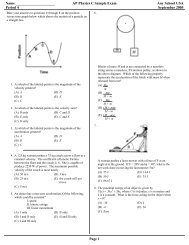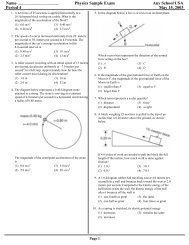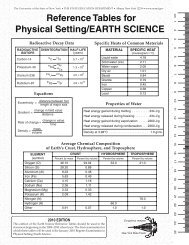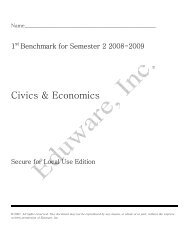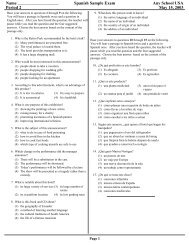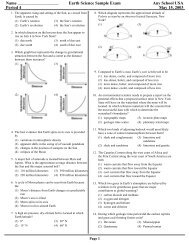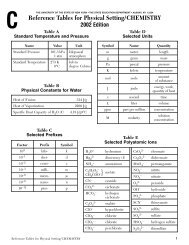NYS Regents Chemistry June 21, 2002 - Eduware
NYS Regents Chemistry June 21, 2002 - Eduware
NYS Regents Chemistry June 21, 2002 - Eduware
You also want an ePaper? Increase the reach of your titles
YUMPU automatically turns print PDFs into web optimized ePapers that Google loves.
1. What is the electron configuration of a sulfur atom in the<br />
ground state<br />
(A) 2–4 (C) 2–8–4<br />
(B) 2–6 (D) 2–8–6<br />
<strong>NYS</strong> <strong>Regents</strong> <strong>Chemistry</strong><br />
<strong>June</strong> <strong>21</strong>, <strong>2002</strong><br />
11. Which of the following atoms has the greatest tendency to<br />
attract electrons<br />
(A) barium<br />
(C) boron<br />
(B) beryllium<br />
(D) bromine<br />
2. The modern model of the atom shows that electrons are<br />
(F) orbiting the nucleus in fixed paths<br />
(G) found in regions called orbitals<br />
(H) combined with neutrons in the nucleus<br />
(J) located in a solid sphere covering the nucleus<br />
3. Which compound contains ionic bonds<br />
(A) NO<br />
(C) CaO<br />
(B) NO 2<br />
(D) CO 2<br />
4. All the isotopes of a given atom have<br />
(F) the same mass number and the same atomic number<br />
(G) the same mass number but different atomic numbers<br />
(H) different mass numbers but the same atomic number<br />
(J) different mass numbers and different atomic numbers<br />
12. Which 5.0-milliliter sample of NH 3<br />
will take the shape of<br />
and completely fill a closed 100.0-milliliter container<br />
(F) NH 3<br />
(s)<br />
(H) NH 3<br />
(g)<br />
(G) NH 3<br />
(…) (J) NH 3<br />
(aq)<br />
13. The strongest forces of attraction occur between molecules<br />
of<br />
(A) HCl<br />
(C) HBr<br />
(B) HF<br />
(D) HI<br />
14. Which graph shows the pressure-temperature relationship<br />
expected for an ideal gas<br />
(F)<br />
(H)<br />
5. What are two properties of most nonmetals<br />
(A) high ionization energy and poor electrical conductivity<br />
(B) high ionization energy and good electrical<br />
conductivity<br />
(C) low ionization energy and poor electrical conductivity<br />
(D) low ionization energy and good electrical conductivity<br />
6. Which element is classified as a noble gas at STP<br />
(F) hydrogen<br />
(H) neon<br />
(G) oxygen (J) nitrogen<br />
7. The percent by mass of hydrogen in NH 3<br />
is equal to<br />
(A) 17<br />
1<br />
× 100 (C) 1<br />
17 × 100<br />
(B) 17<br />
3 × 100 (D) 3<br />
17 × 100<br />
(G)<br />
(J)<br />
8. Metallic bonding occurs between atoms of<br />
(F) sulfur<br />
(H) fluorine<br />
(G) copper (J) carbon<br />
9. Atoms of the same element that have different numbers of<br />
neutrons are classified as<br />
(A) charged atoms<br />
(C) isomers<br />
(B) charged nuclei<br />
(D) isotopes<br />
10. Compared to the radius of a chlorine atom, the radius of a<br />
chloride ion is<br />
(F) larger because chlorine loses an electron<br />
(G) larger because chlorine gains an electron<br />
(H) smaller because chlorine loses an electron<br />
(J) smaller because chlorine gains an electron<br />
15. At the same temperature and pressure, which sample<br />
contains the same number of moles of particles as 1 liter of<br />
O 2<br />
(g)<br />
(A) 1 L Ne(g)<br />
(C) 0.5 L SO 2<br />
(g)<br />
(B) 2 L N 2<br />
(g)<br />
(D) 1 L H 2<br />
O(…)<br />
16. Which change in the temperature of a 1-gram sample of<br />
water would cause the greatest increase in the average<br />
kinetic energy of its molecules<br />
(F) 1°C to 10°C (H) 50°C to 60°C<br />
(G) 10°C to 1°C (J) 60°C to 50°C<br />
17. Which compound is classified as a hydrocarbon<br />
(A) ethane<br />
(C) chloroethane<br />
(B) ethanol<br />
(D) ethanoic acid<br />
Page 1
18. Given the reaction:<br />
Mg(s) + 2 H + (aq) + 2 Cl – (aq) →<br />
Mg 2+ (aq) + 2 Cl – (aq) + H 2<br />
(g)<br />
Which species undergoes oxidation<br />
(F) Mg(s)<br />
(H) Cl – (aq)<br />
(G) H + (aq) (J) H 2<br />
(g)<br />
19. Which formula is an isomer of butane<br />
(A)<br />
(C)<br />
<strong>NYS</strong> <strong>Regents</strong> <strong>Chemistry</strong><br />
26. Which ion is produced when an Arrhenius base is<br />
dissolved in water<br />
(F) H + , as the only positive ion in solution<br />
(G) H 3<br />
O + , as the only positive ion in solution<br />
(H) OH – , as the only negative ion in solution<br />
(J) H – , as the only negative ion in solution<br />
27. The change that is undergone by an atom of an element<br />
made radioactive by bombardment with high-energy<br />
protons is called<br />
(A) natural transmutation (C) natural decay<br />
(B) artificial transmutation (D) radioactive decay<br />
(B)<br />
(D)<br />
28. As ice melts at standard pressure, its temperature remains<br />
at 0°C until it has completely melted. Its potential energy<br />
(F) decreases<br />
(H) remains the same<br />
(G) increases<br />
29. As a sample of the radioactive isotope 131 I decays, its<br />
half-life<br />
(A) decreases<br />
(C) remains the same<br />
(B) increases<br />
20. Which particles are gained and lost during a redox<br />
reaction<br />
(F) electrons<br />
(H) neutrons<br />
(G) protons (J) positrons<br />
<strong>21</strong>. What is the oxidation number of chromium in K 2<br />
Cr 2<br />
O 7<br />
<br />
(A) +12 (C) +3<br />
(B) +2 (D) +6<br />
22. Which process requires an external power source<br />
(F) neutralization<br />
(H) fermentation<br />
(G) synthesis (J) electrolysis<br />
23. A substance that conducts an electrical current when<br />
dissolved in water is called<br />
(A) a catalyst<br />
(C) a nonelectrolyte<br />
(B) a metalloid<br />
(D) an electrolyte<br />
24. Which product of nuclear decay has mass but no charge<br />
(F) alpha particles<br />
(H) gamma rays<br />
(G) neutrons (J) beta positrons<br />
25. Given the reaction:<br />
HCl(aq) + LiOH(aq) → HOH(…)+ LiCl(aq)<br />
30. As an atom becomes an ion, its mass number<br />
(F) decreases<br />
(H) remains the same<br />
(G) increases<br />
31. In which shell are the valence electrons of the elements in<br />
Period 2 found<br />
(A) 1 (C) 3<br />
(B) 2 (D) 4<br />
32. Which of the following Group 15 elements has the greatest<br />
metallic character<br />
(F) nitrogen<br />
(H) antimony<br />
(G) phosphorus (J) bismuth<br />
33. The number of neutrons in the nucleus of an atom can be<br />
determined by<br />
(A) adding the atomic number to the mass number<br />
(B) subtracting the atomic number from the mass number<br />
(C) adding the mass number to the atomic mass<br />
(D) subtracting the mass number from the atomic number<br />
34. A compound has a gram formula mass of 56 grams per<br />
mole. What is the molecular formula for this compound<br />
(F) CH 2<br />
(H) C 3<br />
H 6<br />
(G) C 2<br />
H 4<br />
(J) C 4<br />
H 8<br />
The reaction is best described as<br />
(A) neutralization<br />
(C) decomposition<br />
(B) synthesis<br />
(D) oxidation-reduction<br />
Page 2
35. Given the equilibrium reaction at STP:<br />
N 2<br />
O 4<br />
(g) ↔ 2 NO 2<br />
(g)<br />
<strong>NYS</strong> <strong>Regents</strong> <strong>Chemistry</strong><br />
43. Given:<br />
Which statement correctly describes this system<br />
(A) The forward and reverse reaction rates are equal.<br />
(B) The forward and reverse reaction rates are both<br />
increasing.<br />
(C) The concentrations of N 2<br />
O 4<br />
and NO 2<br />
are equal.<br />
(D) The concentrations of N 2<br />
O 4<br />
and NO 2<br />
are both<br />
increasing.<br />
Which diagram represents a mixture<br />
(A)<br />
(C)<br />
36. What is the total number of oxygen atoms in the formula<br />
MgSO 4<br />
• 7 H 2<br />
O [The • represents seven units of H 2<br />
O<br />
attached to one unit of MgSO 4<br />
.]<br />
(F) 11 (H) 5<br />
(G) 7 (J) 4<br />
(B)<br />
(D)<br />
37. Given the reaction:<br />
6 CO 2<br />
+ 6 H 2<br />
O →C 6<br />
H 12<br />
O 6<br />
+ 6 O 2<br />
What is the total number of moles of water needed to make<br />
2.5 moles of C 6<br />
H 12<br />
O 6<br />
<br />
(A) 2.5 (C) 12<br />
(B) 6.0 (D) 15<br />
38. A student calculated the percent by mass of water in a<br />
hydrate as 14.2%. A hydrate is a compound that contains<br />
water as part of its crystal structure. If the accepted value is<br />
14.7%, the student’s percent error was<br />
0.5<br />
0.5<br />
×100 (H)<br />
(F) 14.2 0.5<br />
(G) 14.7<br />
14.2<br />
14.2⋅100 (J)<br />
14.7 ×100<br />
14.2<br />
14.7<br />
14.7⋅100<br />
39. Which of the following ions has the smallest radius<br />
(A) F –<br />
(C) K +<br />
(B) Cl –<br />
(D) Ca 40. According to Reference Table G, which solution is<br />
saturated at 30°C<br />
(F) 12 grams of KClO 3<br />
in 100 grams of water<br />
(G) 12 grams of KClO 3<br />
in 200 grams of water<br />
(H) 30 grams of NaCl in 100 grams of water<br />
(J) 30 grams of NaCl in 200 grams of water<br />
44. Which process is accompanied by a decrease in entropy<br />
(F) boiling of water (H) subliming of iodine<br />
(G) condensing of water vapor (J) melting of ice<br />
45. If 5.0 milliliters of a 0.20 M HCl solution is required to<br />
neutralize exactly 10. milliliters of NaOH, what is the<br />
concentration of the base<br />
(A) 0.10 M<br />
(C) 0.30 M<br />
(B) 0.20 M<br />
(D) 0.40 M<br />
46. Exactly how much time must elapse before 16 grams of<br />
potassium-42 decays, leaving 2 grams of the original<br />
isotope<br />
(F) 8 × 12.4 hours<br />
(H) 3 × 12.4 hours<br />
(G) 2 × 12.4 hours (J) 4 × 12.4 hours<br />
47. Which mass measurement contains four significant figures<br />
(A) 0.086 g<br />
(C) 1003 g<br />
(B) 0.431 g<br />
(D) 3870 g<br />
41. The gram formula mass of NH 4<br />
Cl is<br />
(A) 22.4 g/mole<br />
(C) 53.5 g/mole<br />
(B) 28.0 g/mole<br />
(D) 95.5 g/mole<br />
42. What is the molarity of a solution that contains 0.50 mole<br />
of NaOH in 0.50 liter of solution<br />
(F) 1.0 M<br />
(H) 0.25 M<br />
(G) 2.0 M (J) 0.50 M<br />
Page 3
48. Which pair of compounds are alcohols<br />
(F)<br />
<strong>NYS</strong> <strong>Regents</strong> <strong>Chemistry</strong><br />
51. Draw the electron-dot (Lewis) structure of an atom of<br />
calcium.<br />
(G)<br />
52. Draw the electron-dot (Lewis) structure of an atom of<br />
chlorine.<br />
(H)<br />
(J)<br />
53. Draw the electron-dot (Lewis) structure of calcium<br />
chloride.<br />
49. The process of joining many small molecules into larger<br />
molecules is called<br />
(A) neutralization<br />
(C) saponification<br />
(B) polymerization (D) substitution<br />
50. The diagram below represents a portion of a 100-milliliter<br />
graduated cylinder.<br />
What is the reading of the meniscus<br />
(F) 35.0 mL<br />
(H) 44.0 mL<br />
(G) 36.0 mL (J) 45.0 mL<br />
Page 4
54. A student is given two beakers, each containing an equal amount of clear, odorless liquid. One solution is acidic and the other is basic.<br />
a State two safe methods of distinguishing the acid solution from the base solution.<br />
b For each method, state the results of both the testing of the acid solution and the testing of the base solution.<br />
Base your answers to questions 55 and 56 on the information and diagram below, which represent the changes in potential energy that occur<br />
during the given reaction.<br />
Given the reaction: A + B → C<br />
<strong>NYS</strong> <strong>Regents</strong> <strong>Chemistry</strong><br />
55. a. Does the diagram illustrate an exothermic or an endothermic reaction<br />
b. State one reason, in terms of energy, to support your answer.<br />
56. On the diagram provided draw a dashed line to indicate a potential energy curve for the reaction if a catalyst is added.<br />
57. Given the reaction at equilibrium:<br />
N 2<br />
(g) + 3 H 2<br />
(g) ↔ 2 NH 3<br />
(g) + 92.05 kJ<br />
a. State the effect on the number of moles of N 2<br />
(g) if the temperature of the system is increased.<br />
b. State the effect on the number of moles of H 2<br />
(g) if the pressure on the system is increased.<br />
c. State the effect on the number of moles of NH 3<br />
(g) if a catalyst is introduced into the reaction system. Explain why this occurs.<br />
Base your answers to questions 58 through 60 on on the information below.<br />
In the modern model of the atom, each atom is composed of three major subatomic (or fundamental) particles.<br />
58. Name the subatomic particles contained in the nucleus of the atom.<br />
59. State the charge associated with each type of subatomic particle contained in the nucleus of the atom.<br />
60. What is the net charge of the nucleus<br />
Page 5
<strong>NYS</strong> <strong>Regents</strong> <strong>Chemistry</strong><br />
61. Base your answers to the following questions on the information given below.<br />
Testing of an unknown solid shows that it has the properties listed below.<br />
(1) low melting point<br />
(2) nearly insoluble in water<br />
(3) electricity<br />
(4) relatively soft solid<br />
a State the type of bonding that would be expected in the particles of this substance.]<br />
b Explain in terms of attractions between particles why the unknown solid has a low melting point.<br />
c Explain why the particles of this substance are nonconductors of electricity.<br />
62. Base your answers to the following questions on the information below.<br />
A hot pack contains chemicals that can be activated to produce heat. A cold pack contains chemicals that feel cold<br />
when activated.<br />
a Based on energy flow, state the type of chemical change that occurs in a hot pack.<br />
b A cold pack is placed on an injured leg. Indicate the direction of the flow of energy between the leg and the cold pack.<br />
c What is the Law of Conservation of Energy Describe how the Law of Conservation of Energy applies to the chemical reaction that<br />
occurs in the hot pack.<br />
63. The table below shows the electronegativity of selected elements of the Periodic Table.<br />
a On the grid set up a scale for electronegativity on the y-axis. Plot the data by drawing a best-fit line.<br />
b Using the graph, predict the electronegativity of nitrogen. _________________<br />
c For these elements, state the trend in electronegativity in terms of atomic number.<br />
Base your answers to questions 64 through 69 on the following redox reaction, which occurs spontaneously.<br />
64. Write the half-reaction for the reduction that occurs.<br />
65. Write the half-reaction for the oxidation that occurs.<br />
Zn + Cr 3+ → Zn 2+ +Cr<br />
Page 6
66. Balance the equation using the smallest whole-number coefficients.<br />
67. Which species loses electrons and which species gains electrons<br />
68. Which half-reaction occurs at the cathode<br />
<strong>NYS</strong> <strong>Regents</strong> <strong>Chemistry</strong><br />
69. State what happens to the number of protons in a Zn atom when it changes to Zn 2+ as the redox reaction occurs.<br />
Page 7
<strong>NYS</strong> <strong>Regents</strong> <strong>Chemistry</strong><br />
<strong>June</strong> <strong>21</strong>, <strong>2002</strong><br />
1. _________ D<br />
2. _________ G<br />
3. _________ C<br />
4. _________ H<br />
5. _________ A<br />
6. _________ H<br />
7. _________ D<br />
8. _________ G<br />
9. _________ D<br />
10. _________ G<br />
11. _________ D<br />
12. _________ H<br />
13. _________ B<br />
14. _________ F<br />
15. _________ A<br />
16. _________ H<br />
17. _________ A<br />
18. _________ F<br />
19. _________ D<br />
20. _________ F<br />
<strong>21</strong>. _________ D<br />
22. _________ J<br />
Answer Key<br />
31. _________ B<br />
32. _________ J<br />
33. _________ B<br />
34. _________ J<br />
35. _________ A<br />
36. _________ F<br />
37. _________ D<br />
38. _________ H<br />
39. _________ A<br />
40. _________ F<br />
41. _________ C<br />
42. _________ F<br />
43. _________ B<br />
44. _________ G<br />
45. _________ A<br />
46. _________ H<br />
47. _________ C<br />
48. _________ F<br />
49. _________ B<br />
50. _________ F<br />
51.<br />
23. _________ D<br />
24. _________ G<br />
52.<br />
25. _________ A<br />
26. _________ H<br />
27. _________ B<br />
53.<br />
28. _________ G<br />
29. _________ C<br />
30. _________ H
<strong>NYS</strong> <strong>Regents</strong> <strong>Chemistry</strong><br />
<strong>June</strong> <strong>21</strong>, <strong>2002</strong><br />
Answer Key<br />
54. a. Examples: -Test with an indicator. -Use Ph paper. -Check for<br />
creativity.<br />
b. Examples: -The base will turn phenolphthalein pink; the acid will<br />
not.<br />
-The acid will turn blue litmus paper red, and the base will turn red<br />
litmus paper blue.<br />
-Bromthymol blue will turn yellow in the acid and blue in the base.<br />
-The acid will react with an active metal like magnesium; the base<br />
will not.<br />
-The acid will have a pH less than 7; the base will have a pH greater<br />
than 7.<br />
55. a. Endothermic<br />
b. Examples: -PE of product C is greater than PE of reactants A and<br />
B.<br />
-Product C absorbed energy and is at a higher PE than reactants A and<br />
B.<br />
56.<br />
b Examples: – Energy flows from the injured leg to the cold pack. –<br />
Heat flows from the higher temperature (the leg) to the lower<br />
temperature (the cold pack). – The cold pack absorbs heat energy<br />
from the injured leg.<br />
c – The energy released from the hot pack is equal to the energy<br />
absorbed by the surroundings. – The total energy of the system<br />
(the hot pack) is equal to the total energy of the surroundings. –<br />
Everything else is constant.<br />
63.<br />
57. a. The number of moles of N 2 (g) increases or more N 2 (g) is made.<br />
b. The number of moles of H 2<br />
(g) decreases, less H 2<br />
(g) is made, or<br />
more H 2<br />
(g) is consumed.<br />
c. There is no effect on the production of NH 3<br />
(g) or that the number<br />
of moles remains the same.<br />
64.<br />
b The electonegativity of nitrogen is 3.0 ()0.2).<br />
c Example: -Atomic number increases—electronegativity<br />
increases.<br />
and<br />
65.<br />
Acceptable responses include, but are not limited to, these examples:<br />
-A catalyst increases the rate of both the forward and the reverse<br />
reactions equally.<br />
-The equilibrium point is reached faster.<br />
-A catalyst does not affect the concentrations of reactants or products.<br />
58. protons and neutrons<br />
59. Protons are positively charged (+) and neutrons have no charge (0).<br />
60. positive or (+)<br />
66.<br />
61. a covalent or molecular or nonpolar covalent<br />
b Examples: -The intermolecular attractions between the particles of<br />
the solid are weak. -Weak intermolecular attractions.<br />
c Example: -There are no freely moving charged particles<br />
62. a exothermic<br />
67. Zn (not Zn 2+ ) loses electrons and Cr 3+ (not Cr) gains electrons.<br />
68. 6e – + 2 Cr 3+ → 2 Cr or reduction or chromium half-reaction or Cr<br />
3+<br />
3+<br />
+ 3e – → Cr.
<strong>NYS</strong> <strong>Regents</strong> <strong>Chemistry</strong><br />
<strong>June</strong> <strong>21</strong>, <strong>2002</strong><br />
69. The number of protons remains the same or is unaffected.<br />
Answer Key
Category Print<br />
1: I. ATOMIC STRUCTURE\4. Electron Location/Energy\A. Bohr Model\1. Principal Energy Levels (Shells) - (2)<br />
2: I. ATOMIC STRUCTURE\3. Isotopes\A. Isotopes\1. Basic Definition - (4, 9)<br />
1: I. ATOMIC STRUCTURE\4. Electron Location/Energy\B. Energy\1. Principal Energy Levels - (1)<br />
1: I. ATOMIC STRUCTURE\2. Subatomic Particles\B. Mass\1. Atomic Mass / Mass Number - (33)<br />
18: I. ATOMIC STRUCTURE\5. Constructed Response\A. Constructed Response\1. Constructed Response - (51, 52, 53, 54, 55, 56, 57, 58,<br />
59, 60, 61, 62, 64, 65, 66, 67, 68, 69)<br />
1: II. PERIODIC TABLE\1. Properties of Elements\A. Metals\1. Metals - (32)<br />
2: II. PERIODIC TABLE\2. Valence Electrons\A. Electron / Ionic Configuration\2. Ionic Configuration - (10, 30)<br />
2: II. PERIODIC TABLE\4. Properties of Periods\C. Electronegativity\1. Electronegativity - (11, 13)<br />
1: II. PERIODIC TABLE\2. Valence Electrons\A. Electron / Ionic Configuration\1. Electron Configuration - (31)<br />
1: II. PERIODIC TABLE\1. Properties of Elements\C. Noble Gases\1. Noble Gases - (6)<br />
1: II. PERIODIC TABLE\4. Properties of Periods\B. Ionic Radius\1. Ionic Radius - (39)<br />
1: II. PERIODIC TABLE\1. Properties of Elements\B. Nonmetals\1. Nonmetals - (5)<br />
1: II. PERIODIC TABLE\6. Constructed Response\A. Constructed Response\1. Constructive Response - (63)<br />
1: III. MOLE/STOICHIOMETRY\4. Calculate Empirical / Molecular Formula\C. Percent Composition\1. Percent Composition - (7)<br />
2: III. MOLE/STOICHIOMETRY\3. Gram Formula Mass\A. Gram Formula Mass\1. Gram Formula Mass - (34, 41)<br />
1: III. MOLE/STOICHIOMETRY\3. Gram Formula Mass\A. Gram Formula Mass\2. Moles of Atoms in a Formula - (36)<br />
2: III. MOLE/STOICHIOMETRY\5. Math and Chemical Equations\D. Mole-Mole Problems\1. Mole - Mole Problems - (15, 37)<br />
1: IV. CHEMICAL BONDING\2. Bond Types\C. Metallic Bonding / Properties\1. Metallic Bonding / Properties - (8)<br />
1: IV. CHEMICAL BONDING\2. Bond Types\A. Ionic Bonding / Properties\1. Ionic Bonding - (3)<br />
1: IX. ACIDS, BASES AND SALTS\3. Reactions\A. Neutralization\1. Recognize Simple Reactions - (25)<br />
1: IX. ACIDS, BASES AND SALTS\2. Theories and Properties\A. Arrhenius Theory\1. Definitions - (26)<br />
1: IX. ACIDS, BASES AND SALTS\1. Electrolytes\A. Electrolytes\1. Definition / Concentration - (23)<br />
1: IX. ACIDS, BASES AND SALTS\3. Reactions\B. Acid-Base Titration\1. Calculate Conc. or Volume - (45)<br />
1: V. PHYSICAL BEHAVIOR OF MATTER\1. Energy\A. Heat (Thermal Energy)\1. Potential and Kinetic - (28)<br />
2: V. PHYSICAL BEHAVIOR OF MATTER\2. Properties of Gases\A. Ideal Gas Model (KMT)\1. Theory - (12, 14)<br />
1: V. PHYSICAL BEHAVIOR OF MATTER\5. Solutions\B. Saturation\2. Determine from Solubility Curve - (40)<br />
1: V. PHYSICAL BEHAVIOR OF MATTER\5. Solutions\C. Concentration\2. Molarity - (42)<br />
1: V. PHYSICAL BEHAVIOR OF MATTER\4. Mixtures\A. Types of Mixtures\1. Homogeneous / Heterogeneous - (43)<br />
1: V. PHYSICAL BEHAVIOR OF MATTER\1. Energy\B. Temperature\1. Average Kinetic Energy - (16)<br />
1: VI. KINETICS/EQUILIBRIUM\3. Equilibrium\A. Description\1. Properties of System - (35)<br />
1: VI. KINETICS/EQUILIBRIUM\4. Entropy\A. Descriptions and Understandings\1. Descriptions and Understandings - (44)<br />
1: VII. ORGANIC CHEMISTRY\1. Hydrocarbons\A. Hydrocarbons\1. Alkanes / Saturated - (17)<br />
1: VII. ORGANIC CHEMISTRY\2. General Properties / Isomers\A. General Properties / Isomers\2. Isomers - (19)<br />
1: VII. ORGANIC CHEMISTRY\3. Other Organic Compounds\A. Functional Groups\2. Alcohols - (48)<br />
1: VII. ORGANIC CHEMISTRY\4. Organic Reactions\C. Polymerization\1. Polymerization - (49)<br />
1: VIII. OXIDATION-REDUCTION\2. Electrochemical Cells\B. Electrolytic Cells\1. Identify and Label Parts/Electron Flow - (22)<br />
1: VIII. OXIDATION-REDUCTION\1. Redox Reactions / Oxidation No.\A. Determining Oxidation Numbers.\1. Oxidation Numbers - (<strong>21</strong>)<br />
2: VIII. OXIDATION-REDUCTION\1. Redox Reactions / Oxidation No.\B. Defining Oxidation / Reduction\1. Basic Definition & Half<br />
Reactions - (18, 20)<br />
1: X. NUCLEAR CHEMISTRY\1. Natural Radioactivity\E. Balancing Nuclear Equations\1. Balancing Nuclear Equations - (24)<br />
2: X. NUCLEAR CHEMISTRY\1. Natural Radioactivity\D. Half-Life\1. Half-Life - (29, 46)<br />
1: X. NUCLEAR CHEMISTRY\2. Transmutation, Fission, and Fusion\A. Artificial Transmutation\1. Artificial Transmutation - (27)<br />
1: XI. LABS AND MEASUREMENTS\1. Labs and Measurements\A. Scientific Method\2. Percent Error - (38)<br />
1: XI. LABS AND MEASUREMENTS\1. Labs and Measurements\B. Measurement and Equipment\1. Equipment - (50)<br />
1: XI. LABS AND MEASUREMENTS\1. Labs and Measurements\B. Measurement and Equipment\2. Significant Figures / Metric Units - (47)
<strong>NYS</strong> <strong>Regents</strong> <strong>Chemistry</strong><br />
Name ________________________________ Class __________________________ Date ___________<br />
1. ___________<br />
2. ___________<br />
3. ___________<br />
4. ___________<br />
5. ___________<br />
6. ___________<br />
7. ___________<br />
8. ___________<br />
9. ___________<br />
10. ___________<br />
11. ___________<br />
12. ___________<br />
13. ___________<br />
14. ___________<br />
15. ___________<br />
16. ___________<br />
17. ___________<br />
18. ___________<br />
19. ___________<br />
20. ___________<br />
<strong>21</strong>. ___________<br />
22. ___________<br />
23. ___________<br />
24. ___________<br />
25. ___________<br />
26. ___________<br />
27. ___________<br />
28. ___________<br />
29. ___________<br />
30. ___________<br />
31. ___________<br />
32. ___________<br />
33. ___________<br />
34. ___________<br />
35. ___________<br />
36. ___________<br />
37. ___________<br />
38. ___________<br />
39. ___________<br />
40. ___________<br />
41. ___________<br />
42. ___________<br />
43. ___________<br />
44. ___________<br />
45. ___________<br />
46. ___________<br />
47. ___________<br />
48. ___________<br />
49. ___________<br />
50. ___________<br />
51.<br />
52.<br />
53.<br />
54.<br />
55.<br />
56.<br />
57.<br />
58.
<strong>NYS</strong> <strong>Regents</strong> <strong>Chemistry</strong><br />
Name ________________________________ Class __________________________ Date ___________<br />
59.<br />
60.<br />
61.<br />
62.<br />
63.<br />
64.<br />
65.<br />
66.<br />
67.<br />
68.<br />
69.



